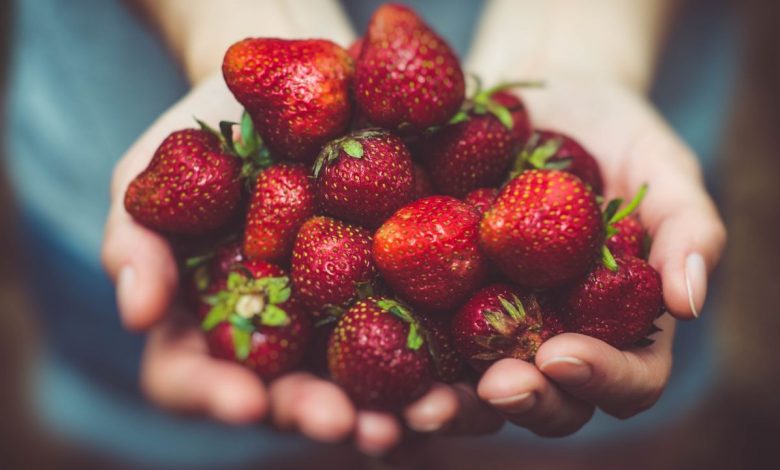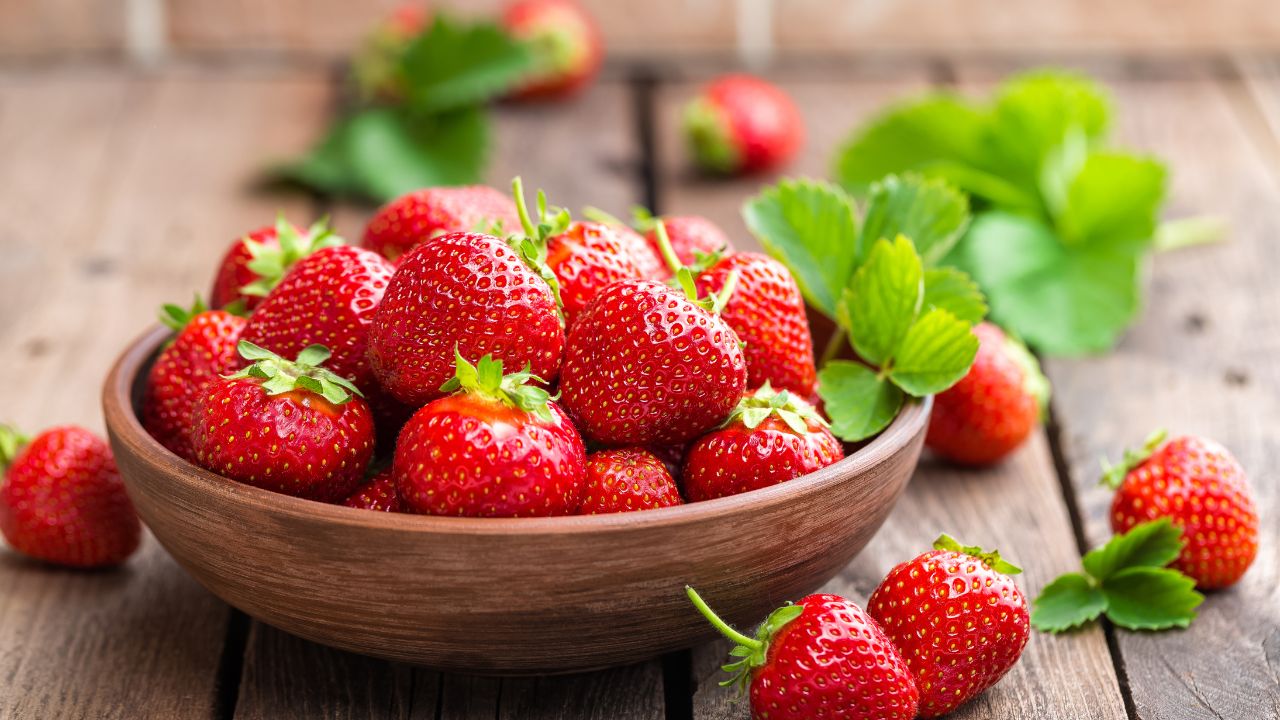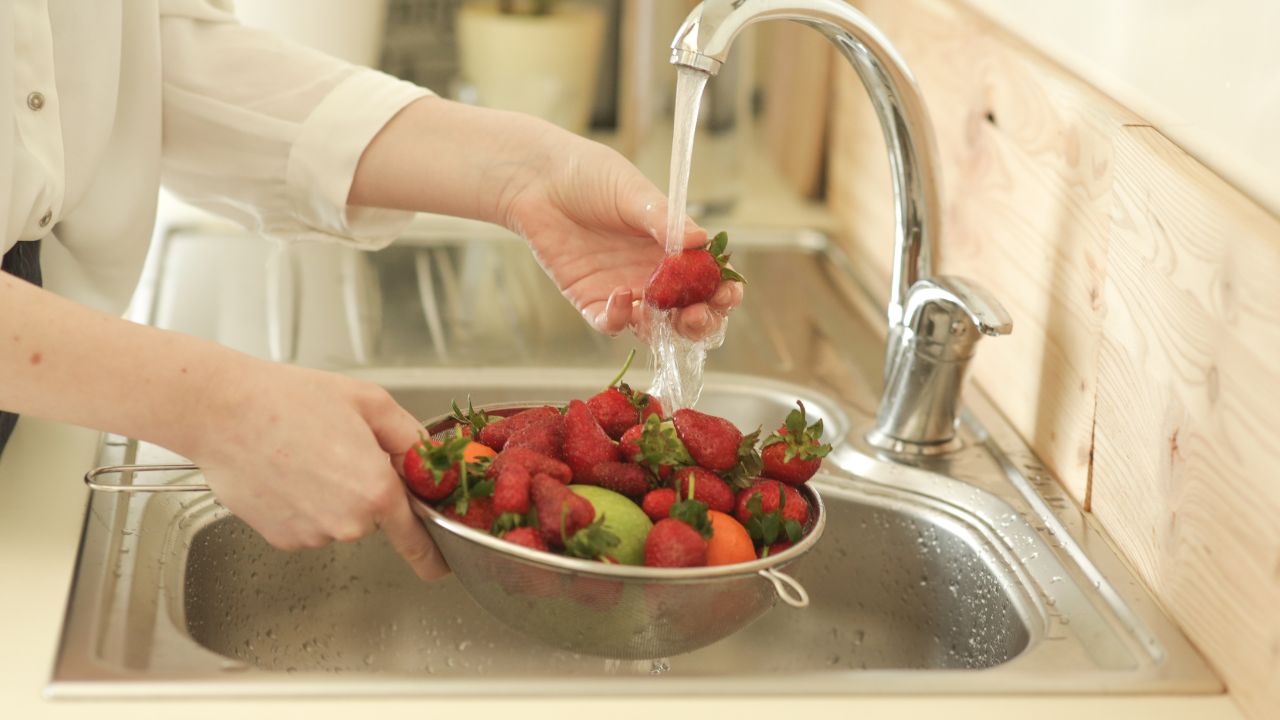
Strawberries are one of the most popular and delicious fruits, but they also require some care and attention before eating. Strawberries can be contaminated with dirt, pesticides, bacteria, or even insects, so it is important to wash them properly to ensure their safety and quality. In this article, you will learn how to clean strawberries using different methods, such as water, vinegar, salt, or baking soda. You will also find some tips and tricks to keep your strawberries fresh and tasty for longer.
Table of Contents,
1. Why You Should Wash Strawberries
Strawberries are among the “dirty dozen” fruits and vegetables that have the highest levels of pesticide residues, according to the Environmental Working Group (EWG). Pesticides are chemicals that are used to protect crops from pests and diseases, but they can also pose health risks to humans and animals. Some of the possible effects of pesticide exposure include headaches, nausea, skin irritation, hormonal disruption, and even cancer.
Besides pesticides, strawberries can also harbor dirt, bacteria, mold, or insects that can affect their flavor, texture, and appearance. For example, strawberries can be infected with salmonella or E. coli, which are harmful bacteria that can cause food poisoning. Strawberries can also attract insects, such as aphids, thrips, or spider mites, that can feed on their juice and leave behind their eggs or excrement .
Therefore, washing your strawberries is not only a matter of preference, but also a matter of safety and quality. By washing your strawberries, you can remove any unwanted substances and enjoy their natural sweetness and freshness.

2. How to Clean Strawberries with Water
The simplest and most common way to wash your strawberries is with water. This method is suitable for organic or locally grown strawberries that have minimal or no pesticide residues. However, water alone may not be enough to remove all the dirt, bacteria, or insects that may be present on the strawberries. Therefore, you should follow these steps to ensure a thorough cleaning:
- Remove any bad or spoiled strawberries from the batch. Discard any strawberries that are bruised, mushy, moldy, or unripe. These strawberries can affect the quality and shelf life of the rest of the batch.
- Do not remove the stems or hulls of the strawberries before washing. The stems and hulls help prevent water from entering the strawberries and diluting their flavor and nutrients. You can remove them after washing and drying the strawberries.
- Place the strawberries in a large colander or strainer and rinse them under cold running water. Gently toss and shake the strawberries to make sure each one gets rinsed. Do not soak or submerge the strawberries in water, as this can cause them to absorb water and become soggy.
- Dry the strawberries with a clean paper towel or cloth. Pat them gently to remove any excess water. Do not rub or squeeze the strawberries, as this can damage their flesh and skin. Alternatively, you can let the strawberries air dry on a paper towel or cloth, but do not leave them wet for too long, as this can promote mold growth.

3. How to Wash Strawberries with Vinegar
Another way to wash strawberries is with vinegar. Vinegar is a natural and effective disinfectant that can kill bacteria, mold, and insects on the strawberries. Vinegar can also help extend the shelf life of the strawberries by preventing them from spoiling too quickly. However, vinegar can also alter the taste and smell of the strawberries, so you should use it sparingly and rinse it well. Here are the steps to follow:
- Prepare a vinegar solution by mixing one part white vinegar and three parts water in a large bowl or basin. You can also use apple cider vinegar instead of white vinegar, as it has a milder flavor and aroma. You will need about one cup of vinegar and three cups of water for a pound of strawberries.
- Add the strawberries to the vinegar solution and swirl them gently with your hands. Do not soak the strawberries for more than 10 minutes, as this can affect their texture and color. You can also add a few drops of lemon juice to the vinegar solution to enhance its disinfecting and deodorizing properties.
- Drain the strawberries and rinse them well under cold running water. Make sure to remove any traces of vinegar from the strawberries, as vinegar can leave a sour or bitter aftertaste. You can also smell the strawberries to check if they are vinegar-free.
- Dry the strawberries with a clean paper towel or cloth. Pat them gently to remove any excess water. Do not rub or squeeze the strawberries, as this can damage their flesh and skin. Alternatively, you can let the strawberries air dry on a paper towel or cloth, but do not leave them wet for too long, as this can promote mold growth.
4. How to Clean Strawberries with Salt
A third way to wash strawberries is with salt. Salt is a natural and cheap ingredient that can help remove dirt, pesticides, bacteria, and insects from the strawberries. Salt can also help preserve the freshness and flavor of the strawberries by drawing out excess moisture and preventing oxidation. However, salt can also dry out the strawberries and make them shrivel, so you should use it moderately and rinse it well. Here are the steps to follow:
- Prepare a salt solution by dissolving one teaspoon of salt in four cups of water in a large bowl or basin. You can use any type of salt, such as table salt, sea salt, or kosher salt. You will need about one teaspoon of salt and four cups of water for a pound of strawberries.
- Add the strawberries to the salt solution and toss them gently with your hands. Do not soak the strawberries for more than five minutes, as this can affect their texture and color. You may notice some dirt, debris, or insects floating in the salt solution, which means the salt is doing its job.
- Drain the strawberries and rinse them well under cold running water. Make sure to remove any traces of salt from the strawberries, as salt can leave a salty or bitter aftertaste. You can also smell the strawberries to check if they are salt-free.
- Dry the strawberries with a clean paper towel or cloth. Pat them gently to remove any excess water. Do not rub or squeeze the strawberries, as this can damage their flesh and skin. Alternatively, you can let the strawberries air dry on a paper towel or cloth, but do not leave them wet for too long, as this can promote mold growth.
5. How to Wash Strawberries with Baking Soda
A fourth way to wash strawberries is with baking soda. Baking soda is a natural and gentle cleanser that can help remove dirt, pesticides, bacteria, and insects from the strawberries. Baking soda can also help neutralize any acidic or sour flavors in the strawberries and make them more sweet and juicy. However, baking soda can also react with the strawberries and cause them to fizz or foam, so you should use it carefully and rinse it well. Here are the steps to follow:
- Prepare a baking soda solution by mixing one teaspoon of baking soda with four cups of water and stirring until dissolved. You will need about one teaspoon of baking soda and four cups of water for a pound of strawberries.
- Add the strawberries to the baking soda solution and toss them gently with your hands. Do not soak the strawberries for more than 10 minutes, as this can affect their texture and color. You may notice some bubbles or foam forming on the surface of the baking soda solution, which means the baking soda is reacting with the strawberries.
- Drain the strawberries and rinse them well under cold running water. Make sure to remove any traces of baking soda from the strawberries, as baking soda can leave a chalky or powdery residue. You can also smell the strawberries to check if they are baking soda-free.
- Dry the strawberries with a clean paper towel or cloth. Pat them gently to remove any excess water. Do not rub or squeeze the strawberries, as this can damage their flesh and skin. Alternatively, you can let the strawberries air dry on a paper towel or cloth, but do not leave them wet for too long, as this can promote mold growth.
6. Tips and Tricks for Cleaning and Storing Strawberries
Here are some tips and tricks to help you clean and store your strawberries in the best way possible:
- Do not wash your strawberries until you are ready to eat or use them, as washing them in advance can make them spoil faster. Store unwashed strawberries in a breathable container or bag in the refrigerator for up to a week.
- Do not hull or cut your strawberries before washing them, as this can expose their flesh and make them lose their juice and nutrients. Hull or cut your strawberries after washing and drying them.
- Do not use hot or warm water to wash your strawberries, as this can cook them and make them mushy. Use cold or room temperature water instead.
- Do not use soap, detergent, bleach, or any other harsh chemicals to wash your strawberries, as these can leave harmful residues or damage the strawberries. Use natural and edible ingredients, such as water, vinegar, salt, or baking soda instead.
- Do not overcrowd your strawberries in the colander, bowl, or basin, as this can cause them to bruise or crush each other. Wash your strawberries in small batches instead.
- Do not store your strawberries in airtight containers or bags, as this can trap moisture and promote mold growth. Store your strawberries in breathable containers or bags instead.
- Do not freeze your strawberries without washing them, as this can lock in any dirt, pesticides, bacteria, or insects. Wash and dry your strawberries before freezing them. You can also hull and slice your strawberries before freezing them for easier use later.
7. FAQs
7.1. How should I store strawberries before cleaning them?
Store unwashed strawberries in the refrigerator. Place them in a single layer on a paper towel-lined tray or container to prevent moisture buildup, which can lead to mold.
7.2. Do I need to wash strawberries before eating them?
Yes, it’s essential to wash strawberries before eating them to remove any dirt, pesticides, or bacteria that may be present on the surface.
7.3. What’s the best way to rinse strawberries?
Rinse strawberries under cold running water. Gently rub them with your fingers to remove any dirt. Avoid soaking them, as strawberries can absorb water and become mushy.
7.4. How do I remove the stems from strawberries?
You can remove strawberry stems by using a paring knife to carefully cut them out in a circular motion. Alternatively, you can use a strawberry huller, a specialized tool designed for this purpose.



